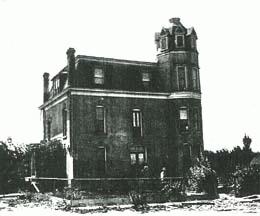The Governor’s Castle
A Fine Governor’s Mansion
By April 1889 Brittain A. Craig (co-owner of the Capital Hill Water Works) and his brother Samuel Craig were building a prospective governor’s mansion in the recently designated Capital Hill neighborhood at the corner of Third Avenue and Chestnut Street. Northwest Magazine reported that “Mr. Craig is putting up the finest brick residence on Capitol Hill in plain view of the city and when somebody asked him the other day if that was the Governor’s mansion, he said it was. Whether some future governor of the state will reside there or not is an open question” (April 1889, p. 20).
This building was three stories with a four-story attached octagonal tower, 36 x 32 feet, and made of brick. Although its tower was slightly suggestive of a castle tower, the mansion’s eventual fate was probably beyond Brittain Craig’s imagination: In 1930 it was remodeled as an apartment house and given a fantasy castle theme complete with a crenellated roofline and battlements.
Ellensburg’s chief rivals for the capital were Olympia and North Yakima (now Yakima), although Waitsburg, Spokane Falls, Waterville, Pasco, Tacoma, and Walla Walla were all contenders.
An Ellensburg land speculation firm called Walters and Company pledged 40 acres as a site for a state house and public grounds and put money into a planned streetcar line connecting Ellensburg’s central business district and the Northern Pacific Depot with the planned Capital area and residential districts. North Yakima residents upped the ante, offering 50 acres of land overlooking the city and $10,000 to pay for moving the capital infrastructure from Olympia to North Yakima. They also placed a deed in escrow to show their good faith.
Narrow, Icy, Worse than King County
Sentiment in Seattle leaned toward keeping the capital in Olympia rather than across the Cascades in either Ellensburg or North Yakima. Newspapers across the state weighed in, with North Yakima and Ellensburg papers predictably taking the fiercest positions. The North Yakima newspaper The Washington Farmer published a blistering (and untrue) anti-Ellensburg tirade:
“There is but one point besides North Yakima that is in the race, and that is Ellensburg — which is twice as high above the sea as North Yakima, therefore it is cold and frosty. Ellensburg is in a valley so narrow it is practically a canyon, and through it sweeps the icy blasts from the snow towering mountains that make the locality one of the most disagreeable and unhealthy in the world — There is no possibility of any branch line of road ever being built from Ellensburg to any other point for the simple fact is that the surrounding rugged mountains form impossible barriers with no signs of a pass through them. The streets of Ellensburg are narrow without a hotel, or running water, and there is not a lawn, or a plot of grass, nor a garden in the village. There are five times as many saloons as North Yakima, and the court dockets show that the criminal classes prevail to a greater degree than they do in King County” (Smith, p. 249).
A Centralia newspaper sank so low as to claim that the name Ellensburg was not dignified enough for a capital city, adding that “no Nancyville or Susantown should be thought of for capital honors” (Smith, p. 249). The Spokane Falls Review sniffed that Centralia was on shaky ground criticizing Ellensburg for its name since Centralia was formerly known as Skookum Creek. And on it went.
The Great Ellensburg Fire
Austin Mires (1852-1936) and John Shoudy (1842-1901), both Kittitas County representatives to the Constitutional Convention, and Ellensburg mayor William Rollins Abrams (1848-1921) left Ellensburg for the state Constitutional Convention in Olympia in early July 1889.
On the evening of July 4, 1889, Ellensburg was consumed by flames. Mayor Abrams rushed back to oversee the deluge of aid that poured into the town and to marshal Ellensburg’s citizens into quick rebuilding efforts. Ellensburg’s active campaign to be named capital for the most part ground to a standstill as residents turned their attention to this more pressing task.

